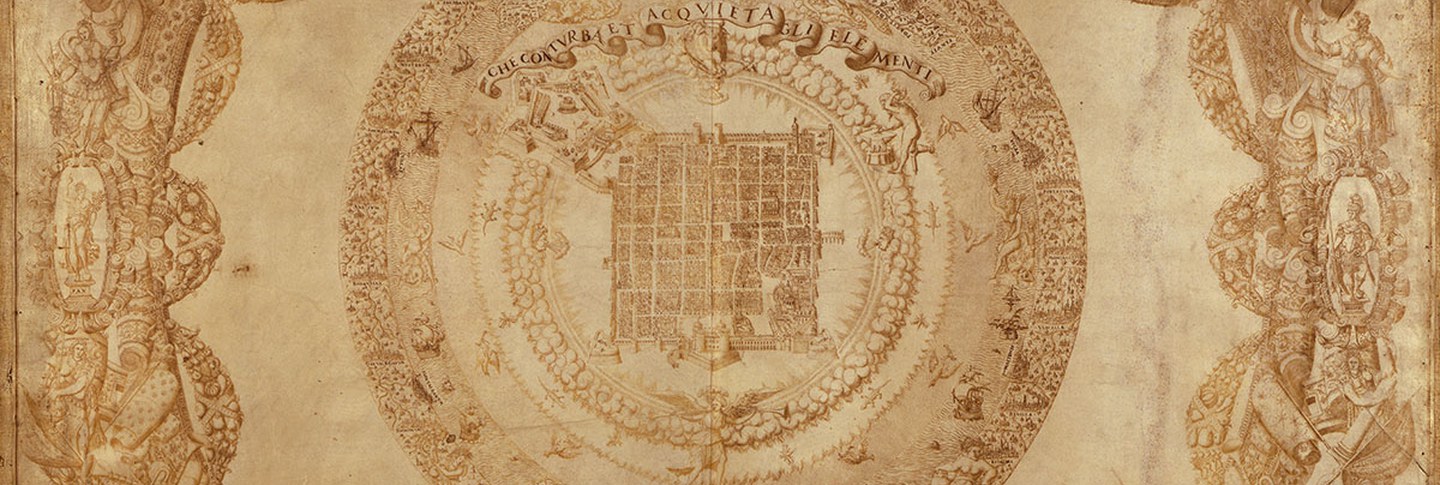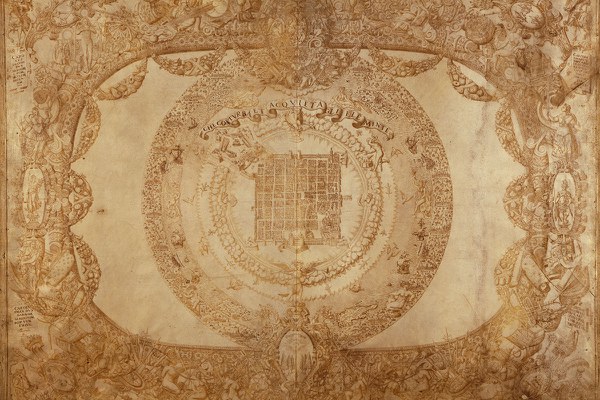When, in the waning years of the sixteenth century, Pope Sixtus V was presented with an elaborately illustrated compendium of city views, he was also regaled with the idiosyncrasy of its production. The artist, working painstakingly to prove a point, had illustrated the entire volume using only his left hand.
That artist, Girolamo Righettino, was the subject of this year’s Garden and Landscape Studies Public Lecture, delivered on November 9 by Denis Ribouillault, an associate professor at the University of Montreal and a former summer fellow at Dumbarton Oaks.
Ribouillault’s talk, titled “Glorifying the City in Counter-Reformation: Girolamo Righettino Rediscovered,” traced Righettino’s involvement in the political life of Venice in the mid-sixteenth century, employing his sole surviving work of art as a case study: a view of the city of Turin executed in 1583.
Righettino, as Ribouillault made clear, was an anomalous figure. Though testimony survives comparing his lost oeuvre to the works of the celebrated mapmakers Abraham Ortelius and Gerard Mercator, Righettino was decidedly less professional. His city views were a hobby, one pursued largely for his own amusement. Lacking traditional training in surveying, Righettino frequently cribbed the technical aspects of his city views from preexisting works, among them Jacopo de Barbari’s famous Map of Venice.
Early in his talk, Ribouillault focused on the political implications of Righettino’s art. A theologian and Lateran canon, Righettino employed his skills as a draftsman diplomatically, attempting to serve his religious order and his Venetian patrons. His illustrations of cities like Rome and Genoa gained him favor with political figures like Marcantonio Barbara; he moved in the same intellectual circles as the luminary Palladio, and was held in high esteem by Venetian senators. Much of this fame derived from the use of his city views as diplomatic gifts—Sixtus V would not have been the only one presented with an original Righettino.
The absence of the bulk of Righettino’s work allows for rich and intriguing speculation, aided by newly discovered contemporary documents. For instance, as Ribouillault demonstrated, it is entirely possible that the aesthetics behind Sixtus V’s large-scale and controversial urban reform program were influenced by the collection of city views given to him by Righettino.
Righettino’s works were often blatantly flattering; their status as diplomatic gifts was even encoded in their composition. The view of Turin displays an act of gift-giving in the lower left corner: a ducal figure beneath a flowing baldaquin receives a book from a diminutive figure, half-boy, half-man. (Righettino, accounts attest, was famously short.)
In the second half of his presentation, Ribouillault began to analyze the ideology of the view of Turin, focusing on its elaborate ornamental and allegorical fecundity. Righettino was not a cosmographer or geographer, as Ribouillault argued, but rather a fine panegyrist whose view of Turin might best be described as an example of “chorography,” that is, a detailed delineation of a particular district or region.
Indeed, Ribouillault took pains to suggest that the most evident spiritual dimension in Righettino’s work was its detail; for the Italian artist, detail was tantamount to prayer. And yet the larger iconographical program of the view of Turin carries its own spiritual weight. As Ribouillault pointed out, the entire composition, in which the image of the city is cloistered within a geometric, ideal order, continuously oscillates between topography and allegory; the city is a grid, and also, by Ribouillault’s analysis, a “ladder toward paradise.”
According to Ribouillault, Righettino was working squarely within the “epideictic tradition of chorography,” in which the image of the city became a visual paean and the traditional cartographic view—top-down and essentially omniscient—was equated with the view of God.
As fantastic and as impressive as Righettino’s view of Turin is, the complex commingling of personal, political, and aesthetic concerns that helped to produce it was not unique to the Italian theologian, even if it does act as an exemplary case study. Toward the end of his presentation, Ribouillault recounted an anecdote about the fourteenth-century Sienese painter Ambrogio Lorenzetti that he believed threw light on Righettino’s own career.
Commissioned by a civic group to deliver an upbuilding triptych, Lorenzetti set about composing The Allegory of Good and Bad Government by imagining an ideal city. It was only after he had begun painting that he made sure this city was Siena.
Video: Glorifying the City in Counter-Reformation Italy: Girolamo Righettino Rediscovered

